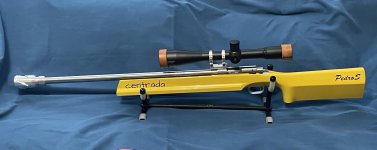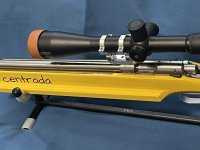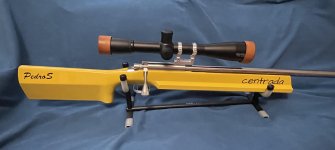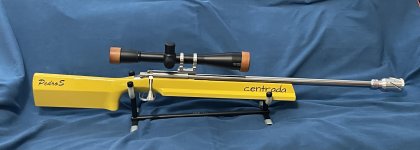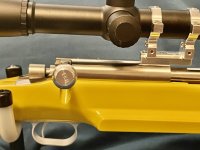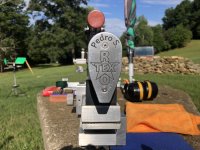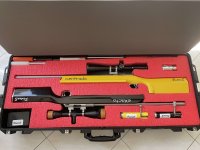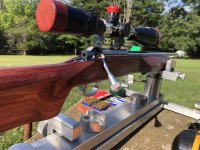That's a very interesting question.
I'll say 322 is a miracle speed to be found, and 330 is a blessing for indoors, if they match the rifle, of course.
That said, we can use both outdoors.
What I have found is a bigger drift for faster ammo vs slower ones.
This is against common sense, as we might think as the faster ammo will reach the target quicker, the wind will have less time to drift it. Well, it's not related to time lapse to target. In fact, the drift is related to air friction (resistance) compounded with direction drift. The faster bullet, as we approach sound speed, exponentially increase the resistance and front turbulence, which contributes to a bigger direction drift.
That's why, as an exemple, if you have brought two lots with the same group size, a slower and a faster, the slower, outdoors, will show an increase group size due to wind, but smaller than the faster one. To put it in numbers, saying a 322m/s has a test of 12mm, and in a 15Km/h wind increases to 15mm, but a 330m/s with a test of 12mm will increase outdoors (same wind) to 17mm.
This is not much if put in perspective, but your scores will be lower, mainly on Xs count, and, sometimes the faster ammo shows a "flyer" to a 9 or even to an 8. These are not flyers, just a sudden larger drift.
Could be an interesting discussion too, how can we determine a flyer vs a higher "normal" drift.
This is my experience and notes I took from my shooting. Yes, I'm constantly taking notes, mostly mentally, but I do it.
The second part of your question is a rather pertinent point.
How can we leverage ours scores with this knowledge.
Several ways.
1st approach is how much you shoot indoors vs outdoors. I do 99% outdoors, so I always look for slower ammo.
But if you end up at the testing with similar consistent groups with a 322m/s and with a 330m/s ammo. Pick booth.
You'll never know how's the wind will be.
Normally, at a match, and if I have 2 great ammo, I'll choose the one to be used during warmup and sighters shots. But I don't do it much as I rather prefer to stay on the safe side using the slower. Why? Couple of reasons. It's one less thing to think about, like, hmm... the wind is slower now, let's pick the faster ammo, ups, now it blows stronger, where's the slower box... you know what I mean? Leave your head clear about everything you can control, and use it just to wind read and POA.
So, I don't leverage.
Of course, if you know well yourself and your rifle, you could start with a faster in calm conditions, changing to a slower if conditions get worse.
What I did found along the years is that, during the 20min you have to shoot a card, seldom a condition varies so drastically that it will need(?) an ammo change.
But then, why I said pick both lots? Because it's a good procedure to practice with faster, and harder, ammo. That's the 2nd approach.
I'll say 322 is a miracle speed to be found, and 330 is a blessing for indoors, if they match the rifle, of course.
That said, we can use both outdoors.
What I have found is a bigger drift for faster ammo vs slower ones.
This is against common sense, as we might think as the faster ammo will reach the target quicker, the wind will have less time to drift it. Well, it's not related to time lapse to target. In fact, the drift is related to air friction (resistance) compounded with direction drift. The faster bullet, as we approach sound speed, exponentially increase the resistance and front turbulence, which contributes to a bigger direction drift.
That's why, as an exemple, if you have brought two lots with the same group size, a slower and a faster, the slower, outdoors, will show an increase group size due to wind, but smaller than the faster one. To put it in numbers, saying a 322m/s has a test of 12mm, and in a 15Km/h wind increases to 15mm, but a 330m/s with a test of 12mm will increase outdoors (same wind) to 17mm.
This is not much if put in perspective, but your scores will be lower, mainly on Xs count, and, sometimes the faster ammo shows a "flyer" to a 9 or even to an 8. These are not flyers, just a sudden larger drift.
Could be an interesting discussion too, how can we determine a flyer vs a higher "normal" drift.
This is my experience and notes I took from my shooting. Yes, I'm constantly taking notes, mostly mentally, but I do it.
The second part of your question is a rather pertinent point.
How can we leverage ours scores with this knowledge.
Several ways.
1st approach is how much you shoot indoors vs outdoors. I do 99% outdoors, so I always look for slower ammo.
But if you end up at the testing with similar consistent groups with a 322m/s and with a 330m/s ammo. Pick booth.
You'll never know how's the wind will be.
Normally, at a match, and if I have 2 great ammo, I'll choose the one to be used during warmup and sighters shots. But I don't do it much as I rather prefer to stay on the safe side using the slower. Why? Couple of reasons. It's one less thing to think about, like, hmm... the wind is slower now, let's pick the faster ammo, ups, now it blows stronger, where's the slower box... you know what I mean? Leave your head clear about everything you can control, and use it just to wind read and POA.
So, I don't leverage.
Of course, if you know well yourself and your rifle, you could start with a faster in calm conditions, changing to a slower if conditions get worse.
What I did found along the years is that, during the 20min you have to shoot a card, seldom a condition varies so drastically that it will need(?) an ammo change.
But then, why I said pick both lots? Because it's a good procedure to practice with faster, and harder, ammo. That's the 2nd approach.


